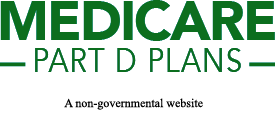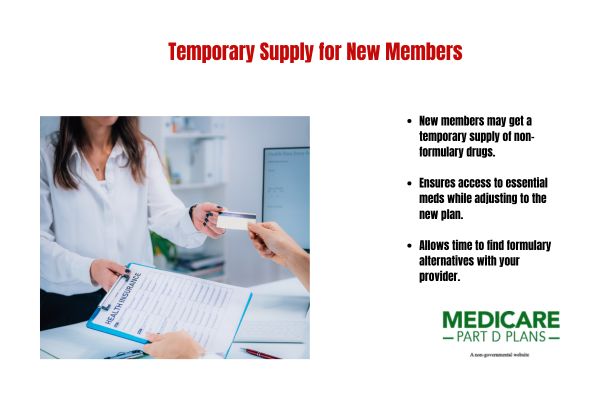Find a Medicare Part D prescription drug plan

Medicare Part D
Prescription Drug Coverage 2026
Blue Cross Blue Shield Medicare Part D Formulary
Curious about which medications may be covered under the Blue Cross Blue Shield Medicare Part D formulary? This article will help you understand how the formulary works, how to access it, and what it might mean for your prescription drug costs.
Key Takeaways
- The Blue Cross Blue Shield Medicare Part D formulary will likely be essential for navigating prescription drug coverage, possibly affecting out-of-pocket costs and access to necessary medications.
- Medications will likely be categorized into drug tiers based on cost, possibly impacting members’ expenses, with lower tiers might include more affordable generic options.
- Members can utilize resources such as this website or one of our licensed agents for guidance on formulary access, drug tier information, and requests for non-formulary medications.
Understanding the Blue Cross Blue Shield Medicare Part D Formulary
The formulary may be more than just a list of medications; it’s a critical tool in managing your prescription drug coverage under Medicare Part D. It will likely outline the covered prescription drugs, helping you navigate your options and help manage your prescription drug costs effectively.
The formulary’s importance cannot be overstated, as it will likely impact your out-of-pocket expenses and access to necessary prescriptions.
Grasping the Blue Cross Blue Shield Medicare Part D formulary could potentially guarantee access to necessary medications. This formulary could serve as a guide, likely directing you to covered drugs and helping you make cost-effective choices. This aspect of Medicare Part D could help in managing both your health and finances.
What is a Formulary?
A formulary is a comprehensive drug list of prescription drugs approved for coverage under certain Medicare Part D plans. This list may include both generic and brand-name drugs, likely providing a range of options that could meet different medical needs.
The Medicare formularies could serve as a critical reference, helping members understand which medications may be covered and guiding them towards cost-effective choices. Formularies could help ensure that members have access to the necessary drugs.
Drug Tiers and Cost Sharing
Drug tiers will likely be a fundamental aspect of Medicare Part D plans, categorizing medications based on their cost and type. Knowing these tiers could help in managing your Medicare prescription drug costs efficiently. Typically, drugs are divided into several tiers, with Tier 1 including the lowest cost drugs, usually generics, and higher tiers encompassing more expensive brand-name medications.
The structure of drug tiers could potentially impact how much you pay out of pocket for your medications. During the initial coverage phase, for example, the enrollee may pay up to 25% coinsurance, while the sponsor might cover up to 65% of the cost.
The tiered structure could help manage healthcare costs and will likely provide access to a broad range of medications. These plans will likely cover a variety of options to help ensure comprehensive coverage.
Understanding Drug Tiers
Drug tiers categorize medications based on their cost and type, which could directly affect your out-of-pocket expenses. Tier 1 will likely include lower cost drugs, often preferred generics, possibly making them the most affordable option for members.
Higher tiers, on the other hand, might include more expensive brand-name drugs and specialty medications, which could lead to increased costs.
The tiered system likely balances prescription drug costs and access to necessary medications.
Lower Cost Sharing Tier Options
Lower cost-sharing tiers could potentially offer significant savings, primarily through the use of generic medications. These generic drugs might be included in the lower tiers, possibly making them more affordable for members compared to brand-name options. Additionally, a generic drug could potentially provide the same therapeutic benefits at a reduced cost.
Prioritizing generic medications may allow plans to manage healthcare costs better, likely offering cost-effective treatment options without compromising quality.
Higher Cost Sharing Tiers
Higher cost sharing tier will likely consist of more expensive drugs, such as brand-name and specialty medications. These tiers might lead to increased out-of-pocket expenses for members, making it crucial to understand which medications fall into these categories.
These certain drugs could be crucial for a specific drug conditions, but managing their costs in the market with careful selection of food and lower-tier alternatives may ease the financial burden.
Potential Formulary Changes and Notifications
Formulary changes may be inevitable, and staying informed about these potential modifications will likely be crucial for managing your prescription drug coverage. Blue Cross Blue Shield will likely ensure that members receive timely notifications about changes to the formulary, helping you stay up-to-date with your medication options.
Members will likely receive at least 60 days’ notice if a drug has been removed from the formulary or tier changes. This advanced notice could allow you to work with your healthcare provider to find suitable alternatives and possibly avoid any disruption in your treatment.
Annual Formulary Review
The annual formulary review is a process that may help ensure the list of covered drugs remain up-to-date and relevant. New generic drugs will likely be assessed for inclusion during the review, while ineffective or unsafe medications are excluded.
This process could help maintain a balance between cost-effectiveness and comprehensive drug coverage, possibly ensuring that members could have access to the most effective and safe medications available.
Receiving Notice of Changes
Members will likely receive an updated formulary if significant changes occur, keeping them informed about their prescription drug coverage. Notifications about formulary changes will likely be detailed and may include information about potential limitations or drug removals, provided at least 60 days ahead of the effective date.
In instances of drug safety issues, a plan may remove a drug from the formulary without prior notice, prioritizing member safety.
Utilization Management Tool
Utilization management tools will likely be designed to promote the safe and effective use of medications by overseeing the prescribing process. These tools may be implemented to help ensure that prescription drugs are used appropriately, possibly helping to control costs while maintaining high standards of patient care. Familiarizing yourself with these tools could help in navigating your prescription drug coverage more effectively.
These tools might include prior authorization, step therapy, and quantity limits, each serving a specific purpose in managing medication use. These tools could potentially ensure medications are used safely and effectively, promoting optimal therapeutic outcomes for members.
Prior Authorization
Prior authorization is a process that requires approval before certain prescription drugs can be filled. This could potentially ensure that the prescribed medication is necessary and appropriate for the member’s condition.
Certain medications may require prior approval from the insurance plan before coverage is granted, likely helping to control costs and ensure the proper use of high-cost or high-risk drugs.
Step Therapy
Step therapy is a protocol that might mandate trying a less expensive and safer medication before progressing to more costly options. This approach could help manage overall healthcare costs by potentially ensuring that lower-cost treatments were tried first, reserving more expensive medications for cases when medically necessary.
By following this stepwise approach, members could potentially reduce their out-of-pocket deductible payment expenses while still receiving effective treatment.
Quantity Limits
Quantity limits might be a restriction placed on the amount of a drug that is covered by a plan within a specific timeframe. These limits could help prevent misuse or overuse of medications, possibly ensuring that members receive the appropriate limit needed for their treatment.
By setting quantity limits, plans may control costs and promote the safe use of medications, helping to achieve proper therapeutic outcomes.
Exception Requests and Appeals
Navigating the process of exception requests and appeals will likely be crucial for managing your prescription drug coverage. If a drug you need is not included in the formulary, you may request an exception to have it covered. Understanding how to initiate this process and what to do if your request is denied could help you secure the necessary medications.
Members may request an exception for non-formulary drugs by following specific guidelines provided by Blue Cross Blue Shield. If an exception request is denied, members will likely be able to appeal the decision by following the appeals process laid out by their Medicare Part D plan. This process could help ensure that members have recourse if they disagree with a coverage determination.
How to Request an Exception
To request an exception, a coverage determination must be initiated, which may be done by the enrollee or their prescriber. This process likely assesses the necessity of a non-formulary drug and determines whether it should be covered based on medical necessity.
Requesting an exception could potentially secure coverage for essential excluded drugs not included in the formulary.
Appeals Process
If your exception request is denied, the appeals process may also allow you to challenge the decision. To initiate an appeal, you must submit a written request along with any necessary information to support your case. This process provides a structured path to contest coverage and decide on necessary medications.
Temporary Supply for New Members
For new members, the transition to a new Medicare Part D plan might be challenging, especially when it comes to accessing necessary medications. To address immediate medical needs, Blue Cross Blue Shield may offer a temporary supply of non-formulary drugs. This policy could potentially ensure that new members have access to essential medications while they adjust to their new plan.
The temporary supply policy could offer a safety net during the transition period, possibly allowing new members to get a temporary supply of non-formulary medications. This could potentially ensure that there are no gaps in treatment as members work with their healthcare providers to identify suitable alternatives within the formulary.
Transition Policy Overview
Eligibility for the transition policy includes eligible members or those switching plans who need immediate drug access. This policy will likely offer temporary access to non-formulary drugs for up to 90 days, providing a maximum of a one month supply for each fill.
This could potentially ensures that new members have sufficient time to consult with their healthcare providers and transition to formulary drugs without interruption.
See plans in your area instantly!
Advertisement
Next Steps After Temporary Supply
After receiving a temporary supply, members might receive notice with a written explanation of the next steps. This may include consulting with their healthcare provider to identify suitable alternatives within the formulary, as approved by the FDA.
Working with healthcare providers will likely ensure a seamless transition and continued access to necessary medications.
Additional Resources and Support
Managing your prescription drug coverage may be complex, but a variety of resources and support are available. By entering your zip code into the Plan Finder Tool on this website, members can understand their benefits and make informed decisions about their healthcare.
Members can access a wide range of tools and resources to help manage their prescription drug benefits. Whether you need help finding and comparing health and drug plans or assistance with enrollment, call one of our licensed agents at 1-866-930-4039 (TTY 711) Mon-Fri: 8am-8pm EST.
Contacting Member Services
For personalized assistance, members can reach out to Blue Cross Blue Shield’s member services through a dedicated hotline. This service supports any inquiries related to your plan.
Online Tools and Resources
Our website is a great resource to help members manage their prescription drug coverage. Members can enter their zip code into this website to check their formulary, understand drug tiers, and explore lower-cost options.
Find a Plan and Enroll Online Yourself!
Advertisement
Summary
Understanding the Blue Cross Blue Shield Medicare Part D formulary will likely be crucial for managing your prescription drug coverage effectively. This formulary could help members navigate the complexities of medication costs and access, possibly ensuring that you have the necessary information to make informed decisions about your healthcare.
From accessing your formulary to understanding drug tiers and managing utilization tools, each aspect plays a vital role in optimizing your coverage.
By staying informed about potential formulary changes and utilizing available resources, you could potentially ensure that your prescription drug coverage meets your needs. Whether you are a new member navigating temporary supply policies or an existing member managing cost-sharing tiers, understanding these components may be essential for effective healthcare management. The available resources, from our licensed agents to this website, can further enhance your ability to manage your benefits.
Taking control of your Medicare Part D coverage will likely involve understanding the formulary, understanding potential changes, and utilizing available resources. Empower yourself with the knowledge to navigate your prescription drug coverage confidently, ensuring that you receive the medications you need while managing costs effectively.
Frequently Asked Questions
What is a formulary and why is it important for Medicare Part D plans?
A formulary is a comprehensive list of prescription drugs covered by Medicare Part D plans, and it could be crucial for helping members find cost-effective medication options while managing their prescription drug expenses. Understanding your formulary could potentially impact your healthcare costs and choices.
What are drug tiers and how do they impact my out-of-pocket costs?
Drug tiers categorize medications by cost and type, with Tier 1 usually featuring low-cost generics and higher tiers might include more expensive brand-name drugs. This structure will likely directly impact your out-of-pocket costs, as lower-tier drugs may require less payment compared to those in higher tiers.
What should I do if a drug I need is not included in the formulary?
If a drug you need is not on the formulary, members should request an exception through a coverage determination. If denied, you may appeal the decision with a written request and supporting information.
How does the temporary supply policy work for new members?
The temporary supply policy will likely allow new members to obtain non-formulary drugs for up to 90 days, possibly ensuring continuous treatment with a maximum of a 30-day supply for each fill. This approach could help facilitate a smooth transition to formulary medications without interruption in care.
Begin Choosing your plan
Advertisement
ZRN Health & Financial Services, LLC, a Texas limited liability company.




